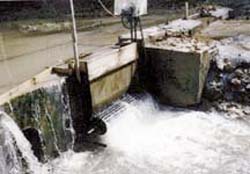
"Can't do it, won't work", was the answer John McMillian got when he looked into developing an electric power generator for a small stream running through his farm. The experts said the vertical drop had to be a minimum of 4 ft., but McMillian had only 2 3/4 ft. of drop.
He decided not to listen to the experts and designed his own hydro electric system that would work on a low-flow stream like his.
"Many landowners look wishfully at a creek flowing across their property and dream of tapping the power of the water," says McMillian. "With a system like mine, they can produce useable amounts of power with just a small dam."
Having built an earth sheltered home at a distance from power lines, McMillian had no interest in paying powerline hook-up charges.
Annual operating costs of an equivalent-sized gas-fired generator would have run him about $850 per year for the power he needed on site. A solar-powered system would have cost about a lot per year over the 20-year life of the system.
The main part of the dam is less than 4 ft. tall. It is 20 ft. long and 18 in. thick. Water flowing over the dam falls 33 in. into a cross-flow design turbine that is 12 in. in diameter and 5 1/2 ft. long. The turbine rotates at 120 rpm's and turns a modified Delco car alternator via a belt drive system. The alternator produces approximately 14 volts alternating current. The voltage is increased to 140 volts using a step-up transformer. Power is fed through a conventional battery charger to charge six 6-volt golf cart batteries located at the house.
Normal operation requires a water flow rate of 5 1/2 cubic feet per second to produce the desired 400 watts or 9.6 kilowatt-hours per day. In late summer and fall, flow decreases to only 4.0 cubic feet per second and power falls to about 100 watts/day.
To help others considering such a system, he has developed a complete design and information packet which he sells.
The manual includes an overview of the system, how to determine the flow of your creek, the design and construction of the turbine and the nozzle, including pictures of the turbine construction. It provides dam construction techniques and describes in detail how to modify a Delco car alternator to produce alternating current. The package also includes professionally drawn turbine, nozzle and dam construction plans.
